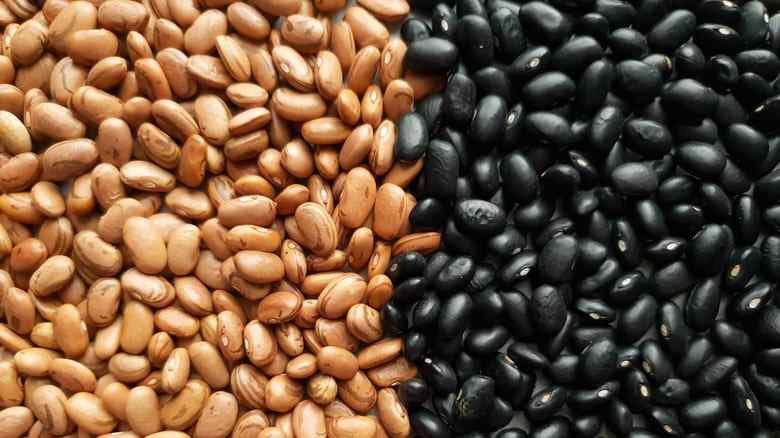I’ve often found myself comparing Peruvian beans and pinto beans, two popular types of beans that have gained widespread attention for their nutritional value and versatility in cooking.
Peruvian beans and pinto beans have distinct nutritional profiles, with Peruvian beans offering more protein, fiber, and minerals, while pinto beans are lower in calories and richer in folate.
But what sets these two bean varieties apart in terms of taste and cooking methods? Can they be used interchangeably in recipes, or do they have unique characteristics that make them better suited for specific dishes?
Origin and History
Peruvian beans are native to Mexico and the Andean region of South America where they have been grown for generations. These beans are small and yellow.
Both Peruvian beans and pinto beans taste delicious and likely originated in Peru. Peruvian beans are known as Canary beans in Peru and as Mayocoba beans abroad.
Bean stew is one of the traditional dishes made with Peruvian beans by indigenous locals of Peru. Peruvian cuisine is a fusion of both national and international cuisines that have amazing flavor and taste with more than 400 typical dishes.
Rooted in indigenous traditions Peruvian cuisine got famous across other cultures of Asia and Eastern regions. Coming to Mexico, Corn is the main base of Mexican traditional cuisine. Apart from corn, few beans and chili have been the “holy trinity” food of Mesoamerican civilizations.
Peruvian beans are suitable for eating just like any other Mexican beans. These small yellow smooth beans are super easy to boil. You can have them whole or mash or refry them as per your cuisine just like any other type of bean in Mexican cooking.
Peruvian beans have a slightly more buttery texture than Pinto or Black beans. Peruvian beans have been part of traditional cuisine for several hundred years.
They have become part of fusion cuisine as they are highly influenced by European, African, and Asian cultures to reflect the nation’s multicultural history.
There are always debates about these beans which belong to the legume family. Myths and superstitions abound. Peruvian beans native to Mexico and South America were the center of debate in the 1990s for a bean named Enola.
A case was filed by copyright and a U.S. Plant Variety Protection Certificate (PVP) against these yellow beans. Another popular myth about these seeds from decades is that beans are bad for digestion.
Few people find them hard on their digestive system as when they consume these beans it makes their stomach upset or feel them bloating.
Physical Characteristics and Appearance

Pinto bean is a spotted variety of common beans. In Spanish, they are referred to as “speckled beans” which is related to molten skin as they become uniform when cooked.
They are oval in shape and beige in color with reddish-brown spots and their size, and uniform in shape when cooked.
Peruvian bean plant can be identified by 3 main physical characteristics and appearance (a) pea-like pods, (b) leaves with plume-like form, and (c) its five petal flower consists of wings, banner, and keel petal arrangement.
Once cooked, Pinto beans offer a slightly nutty flavor and meaty texture. They transform into a buttery creamy texture when cooked at length. You can use them as fresh shell beans or dried ones.
Peruvian beans are smooth textured yellow kidney-shaped beans that have been around from ancient harvesting days to modern superfoods. Their history, diversity, and characteristic features make this bean one of the best alternatives for plant-based meat.
All these factors emphasize their significance in traditional diets and the food industry as potential beans rich in protein and fiber.
Canary beans (yellow and larger), cranberry beans (spotted and creamy), and other unique finds with distinct sizes and colors are a few other popular varieties of beans that are an ideal meal to have for lunch or dinner.
Nutritional Showdown: Which Bean Reigns Supreme?

Both bean varieties Peruvian and Pinto beans are rich sources of macronutrients (protein, fiber, carbs) and key micronutrients (iron, potassium, folate, etc.).
A typical serving of ½ cup of cooked Peruvian beans offers Fiber: 15 grams, Protein: 6 grams, Calories: 140, and Carbohydrates: 29 grams. Whereas the nutritional value of 1/2 cup of Peru beans offers Fiber: 18 grams of, Protein: 16 grams, Calories: 353, and Carbohydrates: 43 grams
Peruvian beans indigenous to Peru and Pinto beans indigenous to Mexico, both have striking similarities as they are easy to cook and can be enjoyed eaten in boiled form, mashed form, or stir-fried. However, there is a slight difference between both of them.
Peruvian beans are more mild and softer than Pinto beans. Another difference is their appearance when dried Peruvian beans look different than Pinto beans.
When boiled, dried Peruvian beans possess a wonderful pale yellow color, which turns into a light beige color, and dried Pinto beans, being pinkish-mauve color, turn brownish.
Note any advantages each bean might hold in particular nutrients. Peruvian beans are soft and possess a buttery creamy texture than Pinto beans.
Both the beans being plant-based are rich sources of protein, soluble fiber, and complex carbohydrates. This feature makes them important to incorporate in a healthy nutritious meal. They play a key role in a balanced diet with all the nutrition required for your body.
Flavor Profile and Texture

Pinto beans are an earthy, mild, nutty flavor, and creamy texture when cooked. These flavors make them a perfect base for strong spices when combined with a dash of hot sauce, red pepper flakes, adobo sauce, smoked paprika, chipotles, cayenne, etc.
Peruvian beans are perfectly creamy and tasty. Their flavor varies by type but can include buttery notes, subtle sweetness, and varying levels of earthiness. When prepared, soups, stews, and bean dips offer a creamy and buttery texture, and other recipes maintain firmness.
Versatility in Recipes

Pinto beans are a good source of vitamins, minerals, and protein. They are best served as appetizers like refried beans, soups, bread, salads, and main dishes. They form versatile combinations when used in a few Mexican dishes like burritos, tacos, etc., as well as American favorites like chili.
Peruvian beans are incredibly versatile to use in classic Peruvian stews and soups, as a colorful addition to salads. Peruvian beans pair well with potatoes, tomatoes, garlic, and onions adding more flavor with minimal spices.
Few other varieties of beans like chickpeas serve as great excellent hummus alternatives. They are great additions to salads, pastas, and curries. Best use these beans to make your better-than-store-bought hummus; that is fresh, herb-packed; and a complete host of other home-cooked dishes.
Pinto beans are a great alternative to Peruvian beans in recipes. Trust me Peruvian beans recipe is mouth-watering in tacos, wraps, taquitos, burritos, and quesadillas.
Not to mention these two varieties of beans, irrespective of their shapes are an incredibly versatile ingredient that can be included in any meal.
They are ideal to pair with both sweet and savory applications. Beans don’t need strong spices and can be prepared very simply and served as a delicious side dish, or they can be incorporated into more complex dishes to boost protein, soluble fiber, and flavor.
Enjoy boiled bean salad on weekends or weekdays to complete your meal! Both the beans, Peruvian and Pinto work well in non-traditional recipes.
Though both the beans pair well with cooked rice you can serve them as side dishes in soups, refried or pureed, and snacking dip.
So, Which Bean is the Winner for You?

Peruvian beans and Pinto beans are nutritious and versatile, offering protein, fiber, and a range of flavors. While both are excellent choices, Peruvian beans have a creamy and buttery taste.
These beans can be cooked in various ways and are ideal for any meal.Beans offer a mild earthy and nutty flavor, and when cooked, become soft with a creamy interior and chewy exterior. They pair well with vegetables, spices, and main dishes like rice.
Whether you prefer strong or mild flavors, there are many bean-based dishes to choose from.Beans can be enjoyed as a central ingredient or as a complement to other dishes. They’re a staple in many Asian recipes, often paired with rice.
Health-conscious individuals enjoy beans with salads or as a side dish. With their unique shapes and textures, beans can be cooked and served in various ways, from stir-fries to soups and salads.


